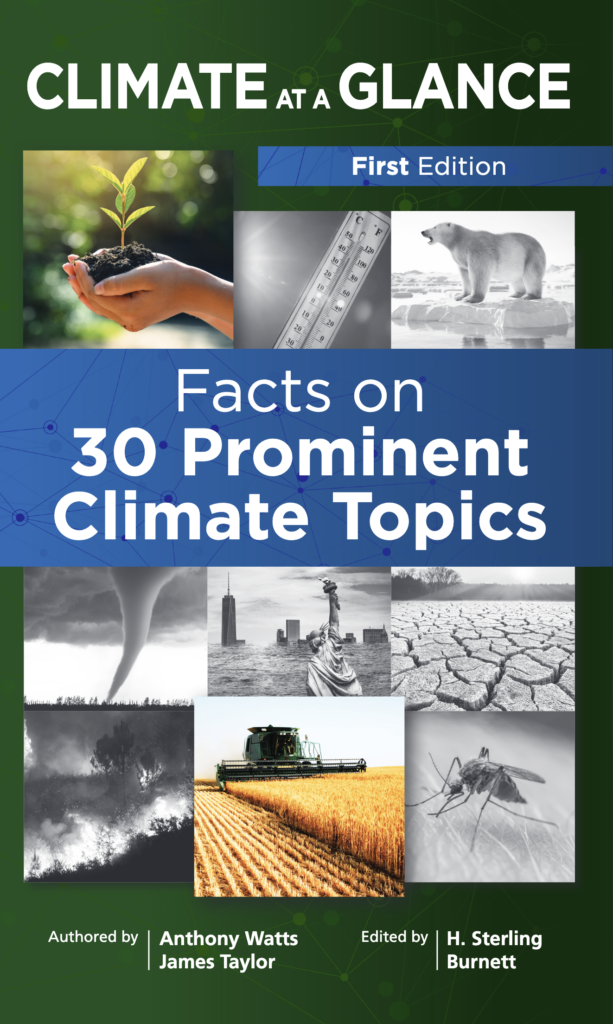Book intended to be reference material to help meteorologists share accurate, non-alarmist data and research about the climate
ARLINGTON HEIGHTS, IL (May 6, 2025) – The Heartland Institute has sent copies of its Amazon best-seller Climate at a Glance: Facts on 30 Prominent Climate Topics to 1,000 meteorologists in the media. Arriving in the mail this week, it provides these influential media members the latest data and research on the climate.

The 80-page book covers 30 climate topics often discussed in the media and provides data to show the earth is not experiencing a climate crisis. The book is designed to be easily utilized by meteorologists to integrate into their work with its breakdown into five sections: (1) Atmosphere and Land, (2) Sea and Ice, (3) Temperatures and Extreme Weather, (4) Humans and Animals, and (5) Scientific and Policy Controversies.
The data in the book – with footnotes in each chapter citing the sources – was compiled by authors Anthony Watts, senior fellow for environmental policy at The Heartland Institute who has worked as an on-air meteorologist since 1978; and James Taylor, president of The Heartland Institute who has been studying and communicating about climate and energy policy for more than 20 years. The book was edited by H. Sterling Burnett, director of The Heartland Institute’s Arthur B. Robinson Center for Climate and Environmental Policy.
Download a free digital copy of the book here. Or you can search for the app for iPhone and Android by searching for “Climate at a Glance.”
For more information about this book distribution, or to interview the authors, please contact Vice President and Director of Communications Jim Lakely at [email protected] or call/text 312-731-9364.
“Meteorologists, the discipline which arguably understands the causes of short-term weather events and long-term trends the best, were among the last to be co-opted by climate alarm,” said book editor H. Sterling Burnett. “Unfortunately, recently this has begun to change with more and more meteorologist sprinkling alarming, but inaccurate, climate messaging into their broadcasts.
“Climate at a Glance is scientifically based, fact-filled refutation of the claim that climate change is causing catastrophic weather changes,” Burnett added. It is my hope that the meteorologists receiving it will review it with a scientifically curious, open mind, and after doing so be persuaded that there is not climate crisis and honestly report that to their respective audiences. Weather watchers deserve the truth about the weather, no fanciful, scary climate hype.”
Among the facts in this book that counter common and false alarmist narratives about the climate:
Crop Production, p. 6: As the climate modestly warms, global crop yields have set new records almost every year. That is due, in part, to longer growing seasons and greater concentrations of carbon dioxide in the atmosphere.
Floods, p. 10: The United Nations Intergovernmental Panel on Climate Change (IPCC) reports it has “low confidence” in climate change is impacting flooding. The annual cost of flood damage in the United States (per GDP) has declined significantly over the last nearly 120 years.
Snowpack, p. 12: Average North American snowpack extent is virtually the same as it was in the late 1960s, when U.S. satellite measurements began. There has been only a modest decline in Eurasian snowpack in recent years.
Coral Reefs, p. 24: Corals thrive in warm water, not cold water, and recent warming has allowed corals to expand their range. The primary causes of coral bleaching are not “global warming,” but sediment and agricultural chemical run offs.
Ocean Acidification, p. 32: Ocean water is not overly acidic with the pH of surface ocean waters falling by merely 0.1 pH units since 1850 and is still well above the neutral pH number of 7.
Sea-Level Rise, p. 36: Global sea levels have risen more than 400 feet since the beginning of the current interglacial period, as it does between ice ages. NASA satellite instruments, with readings dating back to 1993, show global sea levels rising at a pace of just 1.2 inches per decade with no sign that pace is accelerating.
Hurricanes, p. 41: The United Nations Intergovernmental Panel on Climate Change (IPCC) has found no increase in the frequency or severity of hurricanes despite modest warming.
U.S. Heat Waves, p. 49: The all-time high temperature records set in most states occurred in the first half of the 20th century. The heat waves of recent decades have been far less severe and frequent than they were in the 1930s.
U.S. Wildfires, p. 54: Even in the recent worst wildfire seasons, those fires typically burned one-fifth to half as much land as the standard wildfire seasons in the early 20th century.
Climate Refugees, p. 58: Despite much fear-mongering, a majority of the islands from which climate activists predicted would produce “climate refugees” due to sea-level rise have actually seen their landmass increase in recent decades. The United Nations confirms casualties linked to climate-related natural disasters have declined this century.
Polar Bears, p. 69: Polar bear populations have increased dramatically in recent decades despite claims to the contrary made in the media and among climate activists. Polar bears have thrived in much warmer climates than we are experiencing today.
The Heartland Institute is a national free market think tank founded in 1984 in Chicago and now located in Arlington Heights, Illinois. The Economist magazine called Heartland “the world’s most prominent think-tank promoting skepticism about man-made climate change.”
Heartland has organized 15 International Conferences on Climate Change and published the 3,000-page Climate Change Reconsidered series of volumes by the Nongovernmental International Panel on Climate Change.
###

















